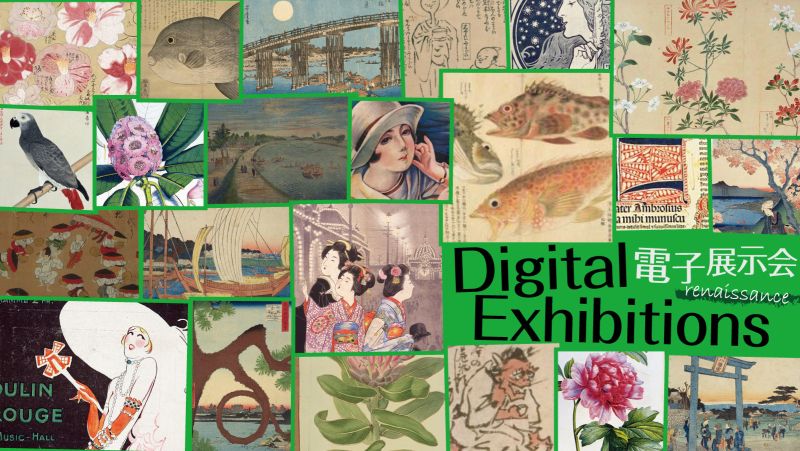TORIYAMA Sekien’s Illustrated Night Parade of the Demon Horde

Gazu hyakki yagyō (Illustrated night parade of the demon horde) is the first of four books by Edo-era artist TORIYAMA Sekien illustrating traditional Japanese supernatural creatures.
Published in 1776, Gazu hyakki yagyō was followed by Konjaku gazu zoku hyakki in 1777, Konjaku hyakki shūi in 1781, and Hyakki tsurezurebukuro in 1784. The NDL Image Bank contains the first, third, and fourth of these; only Konjaku gazu zoku hyakki is unavailable.
Other ukiyo-e artists of the generation that followed Sekien also painted yōkai-e, including Utagawa Kuniyoshi and his pupil TSUKIOKA Yoshitoshi. This webpage features yōkai drawn by a variety of artists, many of whom used Sekien's books as a guide.
Kappa
Kappa are said to lurk in rivers and ponds, where they pull children and horses into the water or flood adjoining fields. In Utagawa Hirokage's Edo meisho doke zukushi ryogoku no yudachi (Clowning around at famous places in Edo: Evening showers at Ryogoku.), kappa are shown trying to pull the God of Thunder, who has fallen off Ryogoku Bridge, into the river.
Kitsunebi
Kitsunebi, or fox-fires , are eerie lights said to have been lit by foxes. On New Year's Eve, in particular, when foxes from all over the Kanto region are said to gather at Oji Inari Shrine in Edo, local villagers would divine the quality of next year's harvest by watching the flow of kitsunebi.
Tengu
Tengu are strange creatures that are said to be either a yōkai that lurks in the mountains or a Shintō god of the mountains. Tengu are often depicted today in human form as mountain ascetics, but TORIYAMA Sekien depicted them as large bird-like figures. On the other hand, tengu drawn by Tsukioka Yoshitoshi also have a more human-like appearance. Yoshitoshi also drew modern tengu flying over telephone poles.
Rokurokubi
Rokurokubi are well-known yōkai with extremely elongated necks. The rokurokubi drawn by TORIYAMA Sekien and Utagawa Toyokuni are women, but in Shinkei sanjurokai-sen omoitsuzura, Yoshitoshi drew a male rokurokubi emerging from a basket. This yōkai is in the form of a giant monk named Mikoshi-nyūdō, who is not really a rokurokubi but Yoshitoshi drew him with his neck stretched out because Mikoshi-nyūdō made a habit of looking down on others.
Umi-zatō and umi-bōzu (Sea monks)
Like kappa, umi-zatō and umi-bōzu are yōkai that are found near water, and some believe them to be the same species. Utagawa Kuniyoshi's Tōkaidō gojyūsantugi: Kuwana depicts a sailor from Kuwana, named Tokuzo, who encounters a giant umi-bōzu offshore. The umi-bōzu asks Tokuzo if he is afraid, and when he replies that living in the world of men is scarier, the umi-bozu disappears.
Kidōmaru
Shown in this picture is Kidōmaru, who kills a cow as it grazes at pasture and lurks in its belly in an attempt to ambush and kill Minamoto-no-Yorimitsu. Ultimately, the plot is discovered, and Kidōmaru is defeated by Watanabe-no-Tsuna, one of the Yorimitsu's shitennō or Four Heavenly Kings.
The saga of Minamoto-no-Yorimitsu and the Four Heavenly Kings is often depicted in ukiyo-e, including episodes such as the conquest of the Shuten-dōji and Tsuchigumo the Spider.
Tamamonomae and the sessho-seki (killing stone)
Tamamonomae appears to be a beautiful woman but in fact she is a nine-tailed demon fox with golden fur. Tamamonomae is famous for deceiving several emperors of ancient China as well as Emperor Toba of Japan and tricking them into committing a series of misdeeds. Legend has it that Tamamonomae was vanquished by the onmyōji (yin-yang master) Abe-no-Yasunari and became the sessho-seki (killing stone), located in the Nasuno area of Shimo-no-kuni, or present day Tochigi Prefecture. Even after dying, the sessho-seki is said to emit a powerful poison, and birds or other animals that pass too near are said to die instantly upon contact.
Bake-danuki (Enchanted raccoon dog)
Bake-danuki are yōkai that appear in the popular Japanese folktale Bunbuku chagama. According to this folktale, a priest at Morin-ji Temple named Shukaku loved to use the Bunbuku chagama--a mysterious kettle that never ran out of hot water no matter how much was poured out of it. But one day it was discovered that Shukaku himself was a tanuki --a Japanese racoon dog-- who had magically turned himself into human form, and he was forced to leave the temple. In Sekien's painting, the tea kettle is the tanuki, but in Yoshitoshin's painting, the monk is.
Hebionna (Snake woman)
Dōjōji engi is a picture scroll from the Muromachi period (1336-1573) that tells the story of a woman who fell in love with a young monk. When she learns that he has betrayed her, she turns into a giant snake and chases him down, burning him to death while he hides inside the bell of the Dojoji temple. In later versions of the story, the monk is named Anchin, and the woman is named Kiyohime. This story became such a popular subject for noh and kabuki plays during the Edo period, that there is a theatrical genre called Dōjōji temple plays. Yoshitoshi repeatedly depicted Kiyohime in his Wakan hyaku-monogatari and Shinkei sanjūrokkai-sen.
Tsukumogami
In TORIYAMA Sekien's Hyakki tsurezure bukuro, there are pictures of tools and utensils from daily life that were transformed into yōkai, also known as tsukumogami. Shown here are tsukumogami of two musical instruments --a biwa and a koto-- as well as a kettle. A comparison with to the tsukumogami that appear in the Hyakki yagyō emaki manuscript that is now available via the NDL Image Bank will show that TORIYAMA Sekien's yōkai paintings were clearly influenced by the earlier work.
Many ukiyo-e depict yōkai like those in the NDL Image Bank. Finding the similarities and differences between the drawing styles of different artists and seeing how they influence each other from work to work is one way of enjoy these materials.
